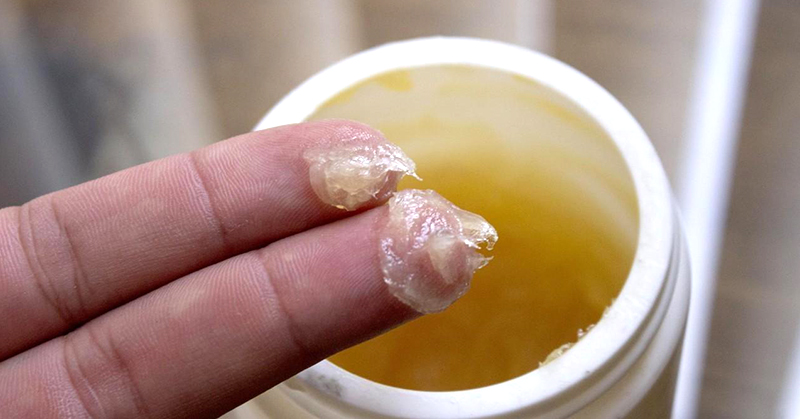Ready to make a soothing muscle rub for back pain that is all-natural and chemical-free?
Well, great. Today I am going to share with you a homemade, soothing muscle rub that is easy and fairly quick to make at home—many of these things you may already have in your kitchen. And the few you don’t, you can easily find at a natural food store or co-op.
Now you may be wondering why cayenne would be the main ingredient for a muscle and joint rub. Great question!
Why Cayenne Pepper Works for Muscle Pain

Capsaicin, one of cayenne’s active constituents, stimulates the release of something known as “substance P” in the body. Substance P is released from nerve cells and the inflammatory cells of the immune system. Substance P is most noted for its role in helping the body perceive pain, and in stimulating the release of various cytokines to induce a healthy inflammatory response.
Cayenne also dilates blood vessels, which allows for more anti-inflammatory cells to make their way to the affected area. When substance P is released and subsequently depleted, as is the case when you repeatedly apply cayenne, the threshold of pain in that area increases. This is also known as pain desensitization. (1,2)
What happens is the area actually feels less painful. This allows you to take some much-needed steps to helping that part of the body heal. Whether it be walking, stretching, exercises or physical therapy, with the assistance of cayenne, you can help your body heal a lot sooner!
Beyond the Cayenne
This rub is full of additional ingredients that will help your tired, achy muscles relax and even heal some!
Coconut oil is a wonderful oil that nourishes the skin. It is antimicrobial which makes it a perfect base for this rub. Coconut oil has been shown to have its own pain relieving and anti-inflammatory properties. (3)
Raw cocoa butter is nourishing to the skin. It contains a high amount of antioxidants (just like chocolate) and will be nicely absorbed by the skin along with the beneficial herbs to help penetrate the muscles below.
Ginger is a spice with a long history of use in both Ayurvedic and Traditional Chinese Medicine. It is naturally anti-inflammatory and warming. When used in a muscle rub, it will help stimulate the movement of blood flow. This allows for new blood to come into the area, bringing with it new immune cells that help push along old blood containing inflammatory cells that have done their job at the site of pain. (4)
Turmeric, similar to ginger, is a spice with a very long history of use for its anti-inflammatory and healing effects. Turmeric will help to reduce swelling and keep the body’s inflammation in check. Remember, inflammation is good for the healing process. But not when the body is chronically inflamed. (5)
Peppermint Essential Oil has menthol in it. This is another common compound used for muscle soreness as it will reduce pain and relax the muscles. Peppermint cools an area, providing similar relief as ice. (6) There is a nice balance here with the ginger and the peppermint. The former is working to warm the area and bring new blood flow and immune cells, while the later is constricting the muscles and moving the blood along to get rid of waste.
Magnesium Oil is an optional ingredient in this recipe, but it is a fantastic way to absorb more magnesium and help reduce symptoms of pain. (7) Known as the master relaxation mineral, applying magnesium topically can help relieve cramps, muscle soreness and pain.
It is a really wonderful combination!
In addition to using the rub for sore muscles, remember to:
- Rest the area. One of the worst things most people do is to not sufficiently rest an area that chronically has pain. Rest is paramount to healing! With low back pain, lying down or sitting with legs up is often helpful.
- Drink plenty of water. Water is needed to carry your blood around. In the blood, there are immune cells just waiting to help reduce inflammation. Adequate water is paramount to healing. Be sure to drink ½ your body weight in ounces of water a day. If you are dealing with an injured area, another 15-20 ounces will go a long way.
- Consider taking turmeric capsules for arthritis pain reduction and healing. Turmeric capsules, 1500mg/day, have been shown to be just as effective as NSAIDs for reducing pain in folks with knee osteoarthritis, and without the side effects like NSAIDS (one of which is delayed healing). (5)
Cayenne Pepper Cream for Muscle & Joint Pain:
- ¼ cup coconut oil
- ¼ cup raw cocoa butter (if you can’t find this, then just use all coconut oil)
- ¼ cup beeswax (grated to facilitate melting process)
- 2 tsp organic Cayenne powder
- 1 tsp organic Turmeric powder
- 1 tsp organic Ginger powder
- 10 drops peppermint essential oil
- Optional: 1-2 tbsp pure magnesium oil
- 4 oz. glass jar
Instructions:
- Place the coconut oil, cocoa butter, and beeswax into a pyrex glass container and place that into a saucepan that contains 2-3 inches of water (the pyrex will be resting in the water).
- Bring the water to a simmer. Continually stir the mixture until the cocoa butter and beeswax are completely melted, along with the coconut oil.
- Add the cayenne, turmeric and ginger powder and stir until they are completely moistened (roughly a minute).
- Remove from heat and add the peppermint essential oil and magnesium oil, if using. Mix well.
- Pour the mixture into a glass jar immediately and allow to cool before placing a lid on top.
- Use liberally on affected area.
Storage: best stored in the fridge due to the fact it does not have preservatives in it. Lasts approximately 6-8 weeks.
CAUTION: be sure to wash your hands after you apply to affected area, as both cayenne and peppermint EO can be very strong. Also, turmeric may cause mild skin yellowing, which is normal (you’ll also want to keep it away from your clothes to avoid staining).
Sources
- Keitel W, et al. Capsicum pain plaster in chronic non-specific low back pain. Arzneimittelforschung. 2001 Nov;51(11):896-903. https://www.ncbi.nlm.nih.gov/pubmed/11765591 Published November 2001. Accessed September 20, 2016.
-
Srinivasan K. Biological Activities of Red Pepper (Capsicum annuum) and Its Pungent Principle Capsaicin: A Review. Crit Rev Food Sci Nutr. 2016 Jul 3;56(9):1488-500. https://www.ncbi.nlm.nih.gov/pubmed/25675368 Published July 3, 2016. Accessed September 20, 2016
-
Zakaria ZA. In vivo antinociceptive and anti-inflammatory activities of dried and fermented processed virgin coconut oil. Med Princ Pract.2011;20(3):231-6. https://www.ncbi.nlm.nih.gov/pubmed/21454992 Published March 2011. Accessed September 19, 2016
-
Ali BH. Some phytochemical, pharmacological and toxicological properties of ginger (Zingiber officinale Roscoe): a review of recent research. Food Chem Toxicol.2008 Feb;46(2):409-20. https://www.ncbi.nlm.nih.gov/pubmed/17950516 Published February 2008. Accessed September 23, 2016.
-
Kuptniratsaikul V. Efficacy and safety of Curcuma domesticaextracts compared with ibuprofen in patients with knee osteoarthritis: a multicenter study. Clin Interv Aging. 2014; 9: 451–458. https://www.ncbi.nlm.nih.gov/pmc/articles/PMC3964021/ Published March 20, 2014. Accessed September 19, 2016.
-
Topp R. Topical menthol, ice, peripheral blood flow, and perceived discomfort. J Athl Train.2013 Mar-Apr;48(2):220-5. https://www.ncbi.nlm.nih.gov/pmc/articles/PMC3600924/ Published March 2013. Accessed September 19, 2016.
- Engen DJ, e. Effects of transdermal magnesium chloride on quality of life for patients with fibromyalgia: a feasibility study. J Integr Med. 2015 Sep;13(5):306-13. https://www.ncbi.nlm.nih.gov/pubmed/26343101
Disclaimer: This information is not intended to be a substitute for professional medical advice, diagnosis or treatment and is for information only. Always seek the advice of your physician or another qualified health provider with any questions about your medical condition and/or current medication. Do not disregard professional medical advice or delay seeking advice or treatment because of something you have read here.

